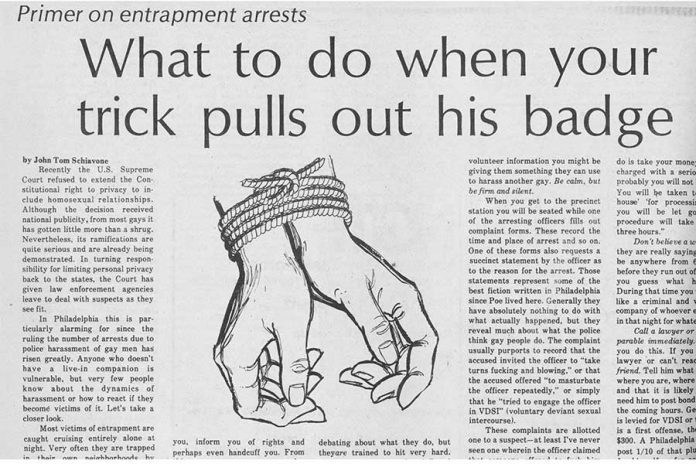Whether one intends it or not, being an openly LGBTQ person is a political act. It was true in 1969, and it is true 50 years later. We are continually fighting for our right to exist and our right to equality. Similarly, a gay newspaper is more than just a newspaper. It’s a community service, an agent of change, and its responsibilities to readers go beyond merely reporting news. In the 1970s, many people were too scared even to pick up the newspaper in public. The paper had a public duty to not just report on the latest political or entertainment news but to show people that it was OK to be themselves. One of the goals of the paper, especially in the early days, was to provide people with information and advice they would find nowhere else.
Such advice sometimes took the form of how-to features. How to take care of your health, how to be safe at night, how to handle discrimination. In June 1976, John Schiavone wrote a feature titled, “What to do when your trick pulls out his badge.” The reason for the story was simple: gay people were continual targets of police harassment, intimidation and entrapment. A plainclothes police officer would troll neighborhoods and wait for people to approach them. They would act normally, engage in conversation, and as soon as the unsuspecting victim would say something like, “Want to take a ride?” the officer’s partner would come out — to serve as proof the officer did not initiate the proposition — and they made the arrest.
In 1976, mutual gay sex in Pennsylvania was classified as VDSI, voluntary deviant sexual intercourse, and it was an illegal offense, as was any attempt to engage in it. The latter is with what the police most entrapped people, often lying to victims about their rights and what would happen after they were booked. They encouraged victims not to get lawyers. They incorrectly recounted the incidents, lying about what the victim said, usually claiming the use of explicit sexual language.
This systemic behavior was standard in cities all across the country. In the 1970s, PGN reported not only on such happenings in Philadelphia but in San Francisco, Boston, New York and other locales. Each city handled its “vice squads” with varying levels of concern. In 1976, some places began the process of banning such entrapment and changing the way the laws worked. Some cities were encouraging it. Regardless, the problem was not going to dissolve overnight. In 2014, a Williams Institute survey showed that 15 percent of LGBTQ people and people living with HIV reported hostile attitudes from law enforcement.
Schiavone’s article gave several pieces of clear, imperative advice to victims of police entrapment. Do not become belligerent when being arrested. Do not answer questions outside of your identity and your address. Do remain silent. Do call a lawyer. Do attempt to expunge the charges. Do not wait to do this.
The article also explained how to recognize plainclothes officers (“They often wear shirts with the tails hanging out”) and their modus operandi (“The whole point of police harassment is to humiliate and inconvenience.”). It reminded readers that the officers were morally wrong, and readers were not. It didn’t ignore the power of law enforcement, but it inspired readers to gather their strength too (“In the meantime, we have to beat the rule makers at their own game. If [the police] can depend on fear and ignorance of their methods, they will only feed on their success. To let that happen would really be a crime.”)
In 1976, there were few resources to get this sort of information, but even fewer resources to get this sort of moral support. LGBT newspapers had a duty to empower their community. That’s what journalism has always been about. The mission remains the same even as communities change. People have a right to be informed about the world around them and to make their choices based on facts. PGN sought and continues to seek the truth. The community deserves it.
